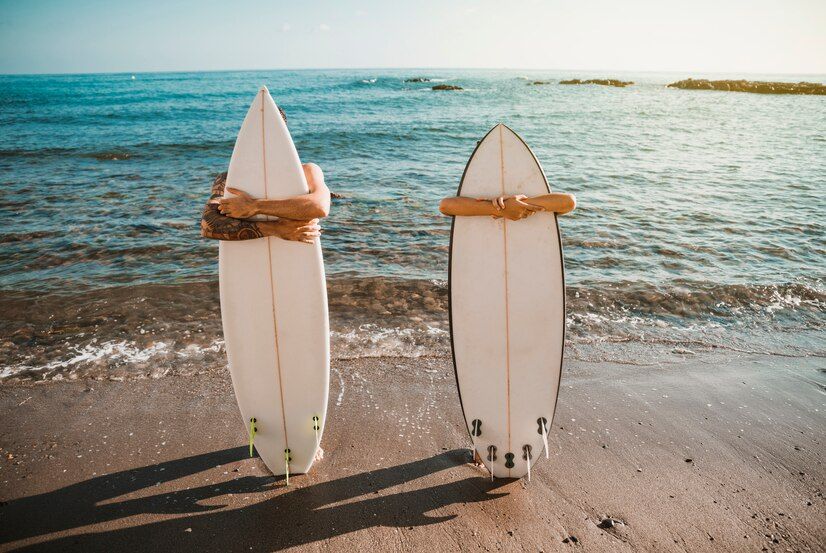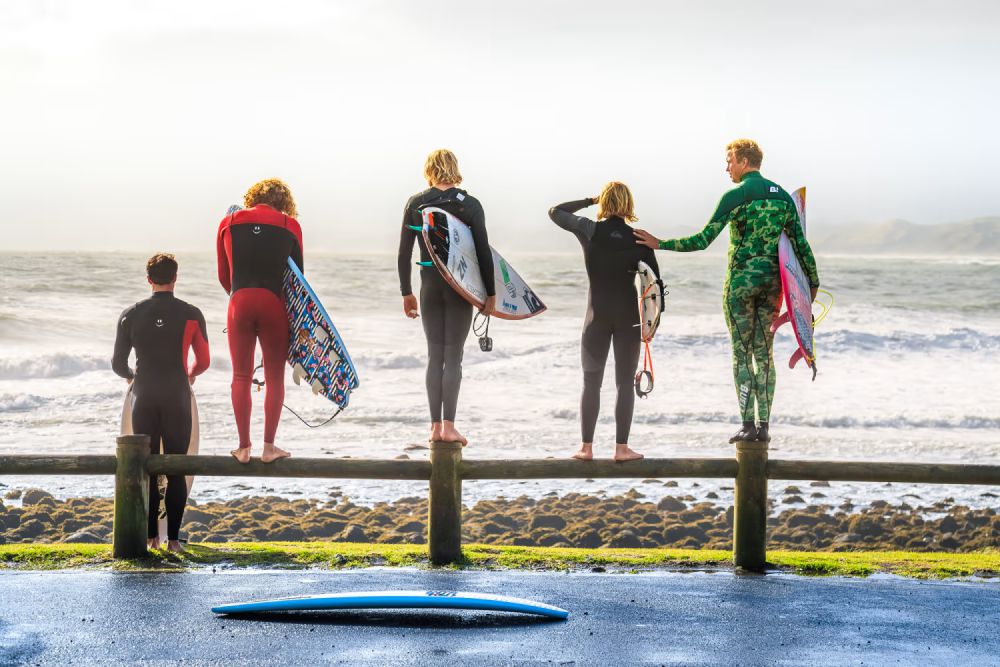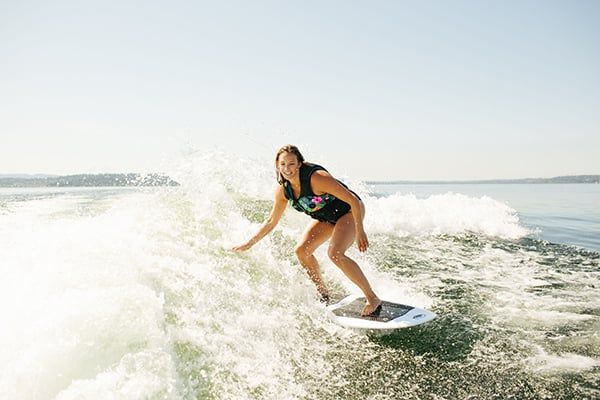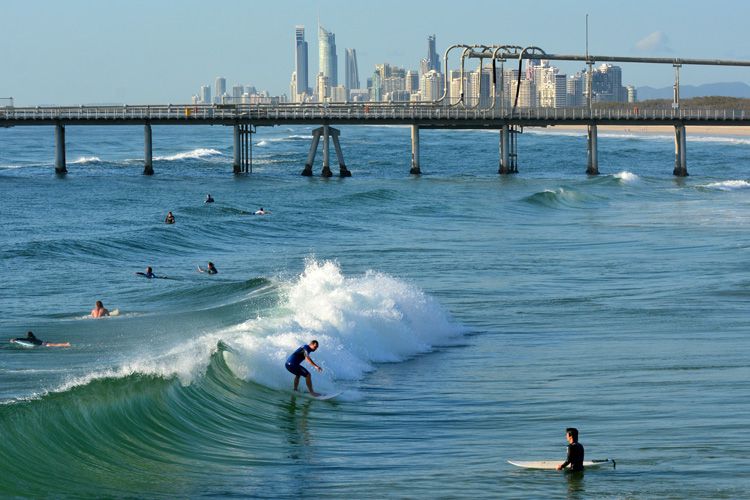El surf, una mezcla de aventura y disciplina, se basa en el respeto por el mar, por los demás surfistas y por el deporte en sí. reglas del surf A menudo, no se mencionan en la lengua oficial, pero se reconocen universalmente y forman la columna vertebral de lo que se conoce como "etiqueta del surf". Ya sea que estés surfeando como un profesional o recién estés comenzando a atrapar tu primera ola, hay algo que no puedes perderte: los conceptos básicos de la etiqueta del surf. El ambiente relajado del surf puede volverse peligroso rápidamente si no se siguen estas reglas, especialmente con las alineaciones cada vez más concurridas de hoy en día.
No seas un surfista más, sé responsable. Surfea con confianza, respeta las reglas. Reglas de alineación de surf , ¡y disfruta de la emoción de surfear de la manera correcta!
1. Derecho de paso
Esto significa que el surfista que se encuentra más cerca del punto donde comienza la ola, conocido como el pico, tiene la primera oportunidad de surfearla. Por lo tanto, cuando estás remando hacia Para coger una ola , mira siempre a tu alrededor para ver si hay alguien en mejor posición para cogerla. Si encuentras a alguien más cerca de la cima, debes retroceder y dejarlo ir. Evita remar a su alrededor o cortarle el paso para coger su ola porque esto es irrespetuoso y peligroso.
A continuación te indicamos cómo determinar quién tiene derecho a ir primero:
- ¿Quién está más lejos? El surfista que está más lejos en el agua o que ha estado esperando más tiempo generalmente es el que sale primero.
- ¿Quién está más cerca de la cima? Si estás más cerca de donde la ola empieza a romper (el pico), tienes derecho a surfearla.
- Primero, primero que nada: Si alguien se levanta primero, podrá tomar la ola.
- Hablemos de ello: Si una ola puede romper hacia la izquierda y hacia la derecha (doble pico), los surfistas pueden gritar "¡Izquierda!" o "¡Derecha!" para que los demás sepan hacia dónde van.
Si alguien más tiene derecho a una ola, déjale que la use. De esa manera, todos tendrán su turno y disfrutarán de su tiempo surfeando.
2. No te dejes caer
El 'dropping in' se produce cuando te lanzas sobre una ola en la que ya está otro surfista. Es uno de los peores errores que se cometen en la historia. Reglas básicas del surf . En pocas palabras, si otro surfista ya ha tomado una ola y la está surfeando, el resto no puede hacerlo. Se trata de respetar el espacio y la velocidad del surfista. "Droping in" es como cortarle el paso a alguien en el tráfico: no solo arruina su experiencia, sino que también puede provocar colisiones peligrosas.

3. Reglas para remar
Los remadores deben evitar el camino de otros surfistas. Cuando regreses a la playa, rema siempre alrededor de la zona donde rompen las olas. Esto evita que interfieras con los surfistas que están cogiendo olas, lo que reduce el riesgo de colisiones.
Si te encuentras en el camino de un surfista en una ola, lo mejor es remar hacia el agua blanca. La idea es evitar la línea del surfista en la parte no rota de la ola.
En segundo lugar, al remar, si te encuentras en una situación en la que te diriges hacia un surfista que se acerca en una ola, la estrategia más segura es remar hacia el agua blanca, no hacia la cara de la ola que no está rota. Remar hacia el agua blanca (la parte rota de la ola) suele ser más seguro y menos disruptivo porque es probable que el surfista que se sube a la ola esté en la parte que no está rota.
4. Mantener el control
Otra regla importante de Reglas de etiqueta del surf Mantén siempre el control de ti mismo y de tu tabla. Teniendo en cuenta las condiciones del día, debes estar en sintonía con tu entorno y surfear según tu nivel de habilidad. Evita enfrentarte a olas demasiado grandes o adentrarte en zonas con muchos surfistas. Quédate en lugares que se adapten a tu habilidad y aléjate de las zonas destinadas a otras actividades. Surfear cuando estás exhausto, enfermo o bajo la influencia de sustancias como el alcohol o las drogas es un rotundo no-no, ya que debilita tu seguridad y control.
5. No deseches tu tabla
Soltar la tabla de surf cuando se acerca una ola, lo que se conoce comúnmente como “dejar caer la tabla”, es un hábito que los surfistas deberían evitar. Al soltar la tabla, se pierde el control sobre ella, lo que crea un riesgo de que golpee a otra persona y provoque lesiones graves.
Además, si te deshaces de la tabla, te expones a toda la fuerza de la ola, además de a los riesgos que suponen el arrecife o el fondo marino. Este tipo de acto suele considerarse un signo de descuido y una falta de respeto por la seguridad y la comunidad surfista. La mayoría de los surfistas necesitan aprender y dominar técnicas como el salto de pato o el giro de tortuga, que te ayudarán a gestionar las olas de forma segura y a mantener el control de tu tabla.

6. Respetar a los lugareños
Respetar a los surfistas locales implica algo más que reconocer su presencia; se trata de valorar su profundo conocimiento del entorno local de surf. En primer lugar, los lugareños poseen un conocimiento inestimable sobre los mejores lugares y horarios para surfear, lo que puede mejorar enormemente tu experiencia. También son conscientes de los posibles riesgos, como rocas ocultas o fuertes corrientes, y sus consejos pueden evitar que sufras accidentes. Además, respetar la cultura única y adaptarse a estas normas demuestra tu respeto por la comunidad de surfistas locales y su lugar de origen.

7. No serpentear
El serpenteo ocurre cuando remas alrededor o te metes delante de alguien que ya está alineado para una ola. Es un movimiento egoísta que rompe la regla del derecho de paso. Hacer esto es de mala educación y arriesgado porque podría provocar un choque o incluso una discusión acalorada. Si te mueves como un serpenteante, prácticamente estás buscando problemas y podrías terminar con una discusión grave entre tus compañeros surfistas. Así que no seas esa persona. Lo mejor que puedes hacer es relajarte, esperar tu turno y ceñirte al orden de la fila.
8. Comunicarse
Una buena comunicación ayuda a evitar malentendidos y posibles conflictos entre surfistas. Puede ser tan simple como hacer contacto visual, usar señales con las manos o asentir con la cabeza. Cuando estés remando y observando una ola, asegúrate de informar a los demás surfistas sobre tus intenciones. ¿Vas a ir hacia la izquierda o hacia la derecha o vas a dejar pasar la ola? Igual de importante es escuchar y responder a las señales de los demás. A través de la comunicación, los surfistas también pueden señalar peligros como rocas, la posible presencia de tiburones o corrientes de resaca. Por lo tanto, es una buena manera de gritar, disculparse si has cometido un error o expresar agradecimiento.

9. Ayudar a los demás
Cuando ayudas a los demás, demuestras que te preocupas por la seguridad y el bienestar de tus compañeros surfistas. Esto podría significar dar algo seguridad en el surf Consejos o recomendaciones para quienes recién comienzan o tienen menos experiencia. También se trata de estar ahí para alguien que está en un apuro, tal vez alguien que está lesionado, luchando contra una corriente de resaca o que está pasando un momento difícil en el agua. Compartir olas, ofrecer equipo de repuesto o incluso llevar a la playa son todas formas de dar una mano. Ayudar no solo es una gran sensación, sino que también crea amistades y un sentido de comunidad entre los surfistas.
10. Respetar el medio ambiente
Deja siempre la belleza natural del lugar tal y como lo encontraste. No tires basura y ten cuidado de no dañar la fauna y flora local. Intenta minimizar el consumo de agua y energía. Evita contaminar el agua o el aire y sé consciente de tu impacto en la erosión y los ecosistemas locales. También es una buena práctica evitar actividades que no sean ecológicas. Todos los surfistas pueden contribuir a reducir su huella ambiental, apoyar iniciativas ecológicas y difundir la concienciación sobre la conservación de nuestros lugares de surf para las generaciones futuras.
11. No navegues más allá de tus capacidades
Las zonas destinadas a aprender a surfear merecen una atención especial. Estas zonas suelen estar destinadas a principiantes con olas más pequeñas y manejables. Si eres un surfista experimentado, es una buena idea darles a los principiantes el espacio que necesitan en estas áreas. Esto garantiza un entorno seguro y estimulante para que los nuevos surfistas desarrollen sus habilidades sin sentirse abrumados o intimidados.

12. Área de aprendizaje Respeto
Las zonas destinadas al aprendizaje del surf merecen una atención especial. Estas zonas suelen estar destinadas a principiantes con olas más pequeñas y manejables. Si eres un surfista experimentado, es una buena idea darles a los principiantes el espacio que necesitan en estas áreas. Este respeto animará a los nuevos surfistas a desarrollar sus habilidades sin sentirse abrumados o intimidados.
13. Disculpas por los errores
Todos cometemos errores y, en el surf, reconocerlos es parte de la buena etiqueta. Una simple disculpa puede ser de gran ayuda si rompes una regla por accidente, como por ejemplo si te subes a la ola de alguien o te metes en ella. Ayuda a mantener un ambiente amistoso en el agua y demuestra que eres responsable y respetuoso con las normas de la comunidad del surf. Los errores son parte del aprendizaje y reconocerlos ayuda a que todos la pasen mejor en el surf.

14. No consumir alcohol ni drogas
Acerca de Reglas y etiqueta del surf : evitar el alcohol y las drogas es una obligación para todo surfista. Estas sustancias afectan negativamente el juicio, la coordinación y el tiempo de reacción, que son vitales para una experiencia de surf segura. Surfear bajo los efectos de estas sustancias puede llevar a tomar decisiones peligrosas y a una falta de control, lo que supone riesgos tanto para ti como para los demás en el agua. Además, perjudica tu rendimiento general en el surf, reduciendo el estado de alerta y la resistencia. Surfear con la mente despejada demuestra respeto por el deporte y su cultura.
15. Comprenda las condiciones de las olas
Comprender las condiciones del surf es fundamental para Reglas y etiqueta del surf . Conocer cómo las mareas, los vientos, el oleaje, las corrientes y los patrones meteorológicos influyen en las olas es fundamental para tomar decisiones informadas sobre dónde y cuándo surfear y qué equipo utilizar. peligros del surf Las corrientes de resaca, los arrecifes poco profundos o el clima impredecible son fundamentales para tu seguridad. Además, adaptarte a los cambios en el entorno del surf, como los patrones cambiantes de las olas o las filas abarrotadas, mejora tu seguridad y el disfrute del deporte. Esta conciencia te mantiene a salvo y profundiza tu conexión con el océano.

Cómo mantenerse fresco en las olas siguiendo las reglas del surf
El surf se trata de divertirse y mantenerse seguro, y ahí es donde conocer las reglas realmente ayuda. reglas del surf Son como un guía amigable que se asegura de que todos se lleven bien en el agua. Más que simplemente evitar contratiempos, se trata de respetar a los demás surfistas y la playa. El hecho de que todos respeten las reglas hace que el surf sea una experiencia mucho más agradable. Es como ser parte de un equipo donde todos se apoyan mutuamente.
Mejora tu experiencia de navegación con Boost Fin , una quilla eléctrica que se puede colocar en cualquier tabla en 5 minutos. Está diseñada para transformar la forma en que surfeamos las olas, ofreciendo diversión y un rendimiento superior. Prueba Boost Fin y descubre cómo cambia tu juego. Hazte con una hoy y hagamos que cada ola cuente con respeto, disfrute y la tecnología avanzada de Boost Fin.


Compartir:
¿Cuánto tiempo se tarda en aprender a surfear?
Remar en el surf: cómo remar en una tabla de surf